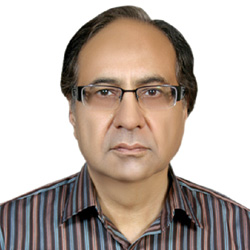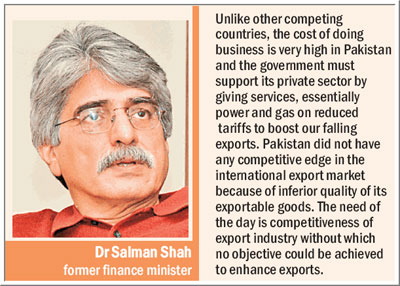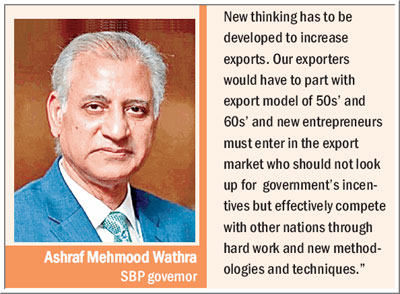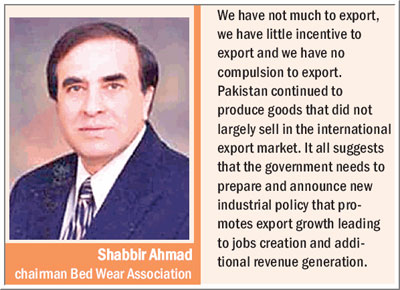INSIGHT
The country’s export sector is choking fast and warrants innovative short and long term measures urgently to arrest declining exports that have already started widening the trade gap disproportionately. The issue gets compounded due to falling home remittances as well as foreign exchange reserves.
 The Rs180 billion export package given by the government a few weeks ago has so far not yielded any results to halt deteriorating export trends. While terming it ‘insufficient’, the exporters want serious action to address the issue.
The Rs180 billion export package given by the government a few weeks ago has so far not yielded any results to halt deteriorating export trends. While terming it ‘insufficient’, the exporters want serious action to address the issue.
Exports have gone down from $24.5 billion in 2012-13 to $20.9 billion in 2015-16 and experts are sounding a warning both to the government and the export industry to play their due roles to arrest the falling exports - a life line for accumulating fast depleting reserves. These reserves have fallen from the peak of $23 billion plus to less than $22 billion, though mostly contained by borrowed external loans and still largely considered inadequate may force the future elected government to once again revert to IMF for emergency lending to avoid any upcoming default.
The country’s exports, which remained stagnant at $24-25 billion during 2010-11 to 2013-14, were declining for the last three years. The situation seeks exigent export oriented investment. How China and India have channeled foreign direct investment (FDI) to stimulate exports are good examples to follow to increase exports.
Earlier three year Strategic Trade Policy Framework (STPF 2015-18) announced by the PML(N) government did not help much to increase exports and discourage unnecessary imports. This STPF is said to have remained unimplemented as all the related efforts aimed at promoting exports could not produce any tangible benefit. Cash support schemes announced with all fanfare under STPF also proved unhelpful for improving product design and encourage innovation.
Blame game between the exporters and the ministry of commerce, however, continues as both sides are accusing each other of doing little to bridge trade gap that is swiftly increasing. While the government urges exporters to improve their competitiveness by diversifying their products through value addition, exporters maintain that they cannot do much as the cost of doing business is still very high. They also lament that the supply of electricity and gas is still to be improved to help increase their productivity to a desired level.
Former finance minister Dr Salman Shah believed that the government will have to play a major role to increase exports as it controls the energy sector. “Unlike other competing countries, the cost of doing business is very high in Pakistan and the government must support its private sector by giving services, essentially power and gas on reduced tariffs to boost our falling exports.”
“Pakistan did not have any competitive edge in the international export market because of inferior quality of its exportable goods.” The exporters face tough competition and must strive hard to compete particularly against China, India, Hong Kong and Bangladesh.
“But in the short term the government must improve its exchange rate to enhance exports”, Dr Shah said, adding that long term solutions are needed instead of achieving any momentary benefit. “The need of the day is competitiveness of export industry without which no objective could be achieved to enhance exports that may result in improved balance of payment position. Moreover supply chain up gradation needs special attention.”
 Prominent exporter and chairman of Bed Wear Association Shabbir Ahmad regretted that over the years the export mix has not changed as a result of which domestic industry was still uncompetitive against its rival countries. According to him there were three fundamentals that explained the country’s failure. “We have not much to export, we have little incentive to export and we have no compulsion to export.”
Prominent exporter and chairman of Bed Wear Association Shabbir Ahmad regretted that over the years the export mix has not changed as a result of which domestic industry was still uncompetitive against its rival countries. According to him there were three fundamentals that explained the country’s failure. “We have not much to export, we have little incentive to export and we have no compulsion to export.”
He explained that Pakistan continued to produce goods that did not largely sell in the international export market. “It all suggests that the government needs to prepare and announce new industrial policy that promotes export growth leading to jobs creation and additional revenue generation,” Ahmad said.
He urged the government to give up political expediency and go for long-term planning to enhance falling exports. “I would blame both the ministers for commerce and finance for not taking any interest to boost exports on one hand and discourage rising imports that have in fact doubled and have created a yawning trade imbalance. Our central bank should also focus on long term gains in facilitating exporters, including to help recover their over Rs150 billion sales tax refunds,” Ahmad said. The export relief package would not do the trick to enhance exports and that without taking policy level decisions and ensuring their implementation, Pakistan would continue to struggle to enhance its exports at some sustainable level, he added.
But Ashraf Mahmood Wathra, governor State Bank of Pakistan (SBP), believed that new thinking has to be developed to increase exports. To begin with, he pointed out, new entrepreneurs should enter the export market who should concentrate on product diversification and market diversification to increase the existing low level of exports.
“Our exporters would have to part with export model of 50s’ and 60s’ and new entrepreneurs must enter in the export market who should not look up for government’s incentives but effectively compete with other nations through hard work and new methodologies and techniques.”
Wathra, who is expected to be given an extension in service by the federal government because of his proactive policies, did not believe that exchange rate was a cause of any worry and said: “the depreciation of our currency would only help in nominal term but would culminate on piling up of more debt.”
He is of the view that now when the weighted average lending is just 7 percent and 5 to 6 percent for the textile sector, the exporters should avail more credit line to  boost their exports. The amount of credit has increased from Rs267 billion in 2015 to Rs350 billion in 2016 which is a sound improvement. The issue of sales tax refund is also being addressed by the government.
boost their exports. The amount of credit has increased from Rs267 billion in 2015 to Rs350 billion in 2016 which is a sound improvement. The issue of sales tax refund is also being addressed by the government.
“This is not a good economic and monetary strategy to devalue rupee for some less gain that in return brings incredible increase in our overall debt burden,” Wathra said. He did not accept that the central bank was manipulating the issue by keeping disadvantageous exchange rate for the exporters. “The government has to protect the interests of all and not the exporters alone.”
The view that the government must develop linkages to have export driven foreign direct investment (FDI) aimed at enhancing exports is gaining strength. The FDI, it is said, can help increase exports through multiple spillover effects on the local exporting firms that in turn can benefit by learning through observing the foreign firms’ export activities, new technologies and modern management techniques.
But then people do talk about the overall security environment further to be improved to attract sizable FDI which is currently hovering between $900 million and $1 billion annually for the last many years. It reached the peak in 2007-08 when the country received $5.5 billion foreign investment. There is no doubt that security situation has greatly improved during the last few years albeit with the help of the armed forces who offered plentiful sacrifices to restore peace across Pakistan particularly in Sawat, Karachi and tribal agencies.
Previously foreign investors and their hundreds of firms made significant profit by investing in Pakistan despite facing security issue which compounded during previous PPP government and the initial one and half years of incumbent PML(N) government.
The government needs to woe and channelize FDI inflows into export oriented market, though during the last decade more than two-thirds of a total of $20 billion foreign investment went into non-manufacturing sectors including construction, oil and gas, telecom and power. In this regard Pakistan has to compete with China, India, Bangladesh, Malaysia, South Korea and Vietnam in terms of ease of doing business to enhance its FDI related exports and the job requires reviewing faulty investment promotion strategy.
 Exchange rate is an issue that needs to be sorted out by the ministry of finance/central bank by negotiating with exporters who maintain that rupee is 20 to 25 percent overvalued against dollar and has to be brought down to boost exports. They often cite the example of China, Turkey, India and Bangladesh which frequently depreciate their currencies against dollar to promote their exports.
Exchange rate is an issue that needs to be sorted out by the ministry of finance/central bank by negotiating with exporters who maintain that rupee is 20 to 25 percent overvalued against dollar and has to be brought down to boost exports. They often cite the example of China, Turkey, India and Bangladesh which frequently depreciate their currencies against dollar to promote their exports.
In comparison with other South Asian countries, Pakistani exports are declining for the last many years with rulers failing to reach at any remedy. Part of the problem is that exporters do have their own inherent weaknesses such as not going into value addition and mainly concentrating on export of raw cotton benefiting countries like Bangladesh.
According to Economic Survey of Pakistan 2014-15, Pakistani exports remained stagnant at $24-25 billion and actually decreased in the year 2016 while Bangladesh’s exports surpassed the $30 billion mark last year and is set to hit $34 billion mark this year. This all is happening due to sluggish growth in Pakistan’s major trading partners – UK-USA and China – due to expensive gas/electricity that always delays in order deliveries.
Major exports including rice, cotton, leather, jewelry and the chemical sector have been hit hard by the slump in exports and the situation calls for drastic improvements. The government needs to help diversify exports whose current base is mostly limited to basic commodities like textiles, leather, cotton, grains, fruit etc. Making a transition from these exports to more value added goods in the global value chain like computer chips, integrated circuits, semiconductors, parts used in mobile and laptop manufacturing and other high tech items seems imperative.
At the end of the day one finds that two important sectors of the economy –exports and agriculture - stumbled since 2013 which is one-third of the country’s Gross Domestic Product (GDP). A positive development is slight growth in agriculture that had remained negative during the last many years.
But the most worrisome is the export earning which have declined by almost 20 percent from $25.1 billion in 2012-13 to $20.8 billion in 2015-16. This decline is calculated to be larger after adjusting for exports under the EU GSP Plus status. Overall there is a decline in both textile and non- textile exports.
Dr Salman Shah
former finance minister
Unlike other competing countries, the cost of doing business is very high in Pakistan and the government must support its private sector by giving services, essentially power and gas on reduced tariffs to boost our falling exports. Pakistan did not have any competitive edge in the international export market because of inferior quality of its exportable goods. The need of the day is competitiveness of export industry without which no objective could be achieved to enhance exports.
Ashraf Mehmood Wathra
SBP governor
New thinking has to bedeveloped to increase exports. Our exporters would have to part with export model of 50s’ and 60s’ and new entrepreneurs must enter in the export market who should not look up for government’s incentives but effectively compete with other nations through hard work and new methodologies and techniques.”
Shabbir Ahmad
chairman Bed Wear Association
We have not much to export, we have little incentive to export and we have no compulsion to export. Pakistan continued to produce goods that did not largely sell in the international export market. It all suggests that the government needs to prepare and announce new industrial policy that promotes export growth leading to jobs creation and additional revenue generation.
Going forward the phenomenal low export base has to be improved along with policy decision to ensure value addition of products. Both the finance and the commerce ministers, who are being accused of side stepping the export issue must take into confidence the exporters’ community.
The writer is Islamabad based senior journalist